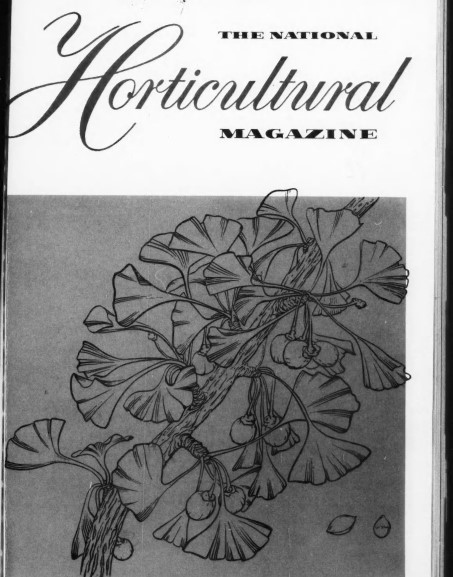The Christmas Rose for Winter Flowers
KARL F., FISCHER
The Christmas Rose for Winter Flowers – The genus Helleborus is a member of RANUNCULACEAE, the Crowfoot or Buttercup Family. Several species and cultivars of this genus are known. The Christmas Rose, Helleborus Niger, although by no means a common plant, is, perhaps, the best known and most commonly cultivated species.
The Christmas Rose is interesting not only botanically, but also from the legendary and the medicinal points of view.
The species H. Niger and its numerous cultivars are particularly valuable because of the flowering season, which extends from October until March—a time when few flowers are found in gardens in many geographical areas.
An individual plant, of course, will not flower during all these months; the time depends upon the particular cultivar, the
section of the country, and even variations of temperature from year to year.
THE PLANTS
The Christmas Rose has been well known in Europe for many years. The plants are grown there in favorable garden locations and considerable use is made of their cut flowers. They are excellent for corsages and may be worn out-of-doors during cold winter days. They combine well with hollies and other Christmas greens for table decorations.
European florists sell potted plants of Helleborus during the Christmas season. They also move clumps into the cool greenhouse, or pit, at regular intervals for cut flower production. It is interesting to note that these cut flowers bring prices comparable to the first forced tulips available at the same time.
In this country, plants of Helleborus were hardly known some twenty years ago. They still are considered a novelty in spite of the fact that leading horticultural magazines have recently published excellent articles on their culture pointing out their unusual qualities.
The flower is borne one on a stem; frequently, one or two smaller flowers will appear on the same stem below the main flower. The flower is single having five white petals, often flushed on the outside with purplish rose, and measuring from 2-4 inches. A well-grown plant might produce 150 twelve-inch flower stems. When the flower fades, the petals turn rose, later greenish, and will last for months even though the fruit has formed.
The leaves are basal, divided into seven or more evergreen, or nearly Evergreen, leaflets, and on mature and well grown plants, have stems not more than 18 inches long.
It is necessary to start with plants of sufficient size and vigor to ensure success.
The writer believes that this is of utmost importance and that failure in the culture can almost always be attributed to failure in selecting good plants.
Helleborus plants are like many other alpines which are difficult to establish but are comparatively easy to grow once they have reached a certain size and age. As they are still considered a novelty, it may be difficult for the average gardener to know what constitutes a plant of sufficient size. A description of the methods of propagation may help to clarify this pot.
PROPAGATION
Helleborus Niger may be propagated by division and by seed. Of course, if it is desired to perpetuate a_ particular quality of a strain, division is necessary.
This should be done in the early fall because new roots form rapidly then. The division should be promptly planted into a carefully prepared nursery bed and grown there for at least one year.
Those plants developing two strong leaves, or more. and a good root system are considered sufficient in size for transplanting to permanent locations. Propagation by division is comparatively simple. Helleborus slowly grows to a sizeable plant large enough to be divided, however, and it becomes necessary to propagate by seed when a large quantity is desired.
The flowering time falls in the winter months and seed ripens during early spring. To preserve their viability, these must be sown immediately or temporarily stored in moist sand. Stored seed planted indoors germinate in November or December, while stored seed planted outdoors in October, germinate in March or about ten months after harvest.
During the first season, the seedlings develop few roots (but these often 12 inches long). The top growth is confined to two or three small leaves with less than the usual number of leaflets.
During the second growing season, the new set of leaves increases in size but usually a third season is required to produce a plant which is comparable in every respect to one which has been grown from a division.
It may follow, that regardless of which propagation method is employed, it takes several years to produce mature plants. This, coupled with the fact that losses among seedlings are high, is the reason that the Christmas Rose is still rather scarce and high priced.
Concerning the propagation from seed, there exists another fact which is unique due to the unusual flowering time. Seeds of early
flowering plants (October-January) frequently do not mature.
Seeds of early flowering plants (October-January) frequently do not mature. This is usually caused by inclement weather. The propagator should provide some form of protection for these flowers to mature their seeds, or else he will have to depend on the later blooms for seed production and this, in turn, might tend to develop late flowering strains divesting Helleborus Niger of its most desirable quality.
SHADE AND MULCHES
Attention must be turned to the cultural needs after good plants have been secured. It should be realized that the requirements of the Christmas Rose are different from those of border perennials. They are indigenous to the Mediterranean mountains where summer temperatures are lower than those found in most parts of the United States. Accordingly, the gardener should provide shade and mulching material from April until August.
During April and May, the foliage is still tender and wilts easily in wind and sun, even though there may be considerable moisture in the ground.
Wooden lath, bamboo, reed mats, aluminum lath, or evergreen boughs which have lost their needles, will be satisfactory. It should not exclude more than forty per cent sunlight. The shade should be supported on a framework at least 18 inches from the ground.
The framework may be used later to support sash or other winter protection, whenever such seems to be desirable. Artificial shade is usually preferred because it may be removed during the months of lower light intensity.
DON’T STOP NOW! 👀
“The Christmas Rose for Winter Flowers”
 Our 100% Money Back Guarantee:
Our 100% Money Back Guarantee:
If for any reason you decided within 90 days that “The Christmas Rose for Winter Flowers” isn’t for you, simply notify us by email and we’ll gladly refund your money – no questions asked. That’s our Ironclad Guarantee! The risk is entirely ours! You absolutely have nothing to lose!
[wpforms id=”97″]
Your Name and Email will Never Be Shared or Given to Anyone.
We keep our subscriber’s privacy sacred. We do not sell or rent your personal information to other parties. What’s more you can always unsubscribe at any time!
Warmest Regards,
Coyalita Linville
Copyright © 2023 – 2024 Sunrise-Sunset-Nature-Gardens.com. All Rights Reserved Privacy Policy – Earning Disclaimer – Terms of Use – Contact Us
Open modal

